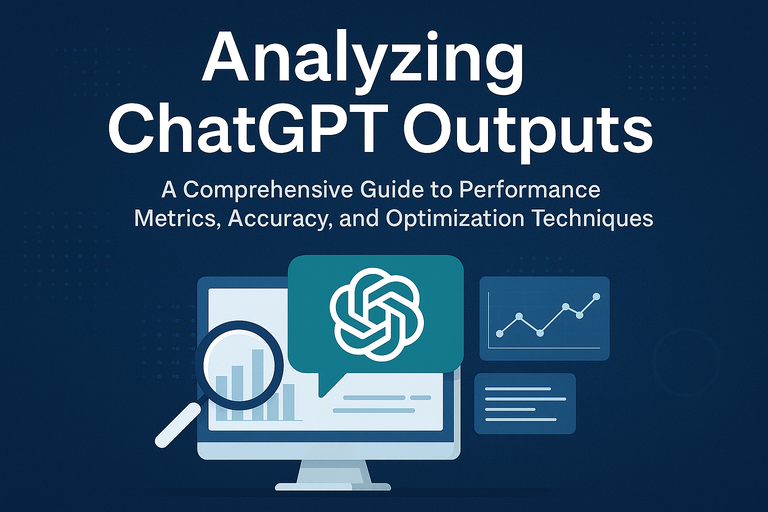Analyzing ChatGPT Outputs: A Comprehensive Guide to Prompt Performance Metrics, Response Accuracy, and A/B Testing
Estimated reading time: 10 minutes
Key Takeaways
- Employ clear metrics like relevance, accuracy, coherence, and engagement to evaluate ChatGPT outputs.
- Adopt systematic processes—from data collection to qualitative reviews—to gain actionable insights.
- Use A/B testing and prompt optimization techniques to continuously improve response performance.
- Leverage tools like embedding comparisons, fact-checking APIs, and analytics platforms for automation.
Understanding ChatGPT Outputs
ChatGPT outputs are the responses generated by the AI model based on user prompts. These responses can take various formats:
- Plain text responses
- Formatted text using Markdown
- Structured data (JSON, CSV)
- Lists and tables
- Code snippets
- Charts and images (via DALL·E integration)
It’s essential to understand different ChatGPT output formats to set appropriate evaluation criteria.
Why Analyze ChatGPT Outputs?
Analyzing outputs is crucial for several reasons:
- Ensuring accuracy and reliability
- Maintaining a consistent brand voice
- Meeting regulatory compliance requirements
- Avoiding potential risks like AI hallucinations
- Driving user engagement and satisfaction
Without proper analysis, organizations risk spreading misinformation and damaging their reputation. For advanced analysis techniques, see How to use ChatGPT’s advanced data analysis feature and Data analysis with ChatGPT.
Evaluating Prompt Quality
Prompt quality directly impacts the usefulness of ChatGPT’s responses. High-quality prompts exhibit:
- Clarity: Using unambiguous language and clearly defined terms
- Specificity: Including precise instructions about desired outputs
- Context: Providing relevant background information and examples
Compare these examples:
High-quality prompt: “Summarize the key findings of this peer-reviewed medical study in 100 words, citing sample size and p-values.”
Low-quality prompt: “Tell me about this study.”
For more insights on avoiding common pitfalls, refer to Common ChatGPT Prompt Mistakes: How to Troubleshoot, Optimize, and Improve Accuracy.
Prompt Performance Metrics
To effectively evaluate prompt quality and response effectiveness, consider these key metrics:
Relevance
- Measure semantic alignment between prompt intent and response
- Use embedding comparison techniques
- Calculate cosine similarity scores
- Target similarity scores above 0.70
Accuracy
- Verify factual correctness against authoritative sources
- Use manual and automated fact-checking methods
- Calculate accuracy percentage based on correct facts vs. total claims
Coherence
- Assess logical flow and readability
- Use tools like Flesch-Kincaid Grade Level scoring
- Measure response perplexity when applicable
Engagement
- Track user interaction metrics
- Collect feedback through surveys
- Monitor time-on-response and scroll depth
Measuring ChatGPT Response Accuracy
To measure response accuracy effectively:
- Manual Verification
- Compare claims against primary sources
- Consult subject matter experts
- Document verification results
- Automated Fact-Checking
- Integrate with verification APIs
- Cross-reference against trusted databases
- Use confusion matrices for classification tasks
- Statistical Validation
- Implement precision and recall metrics
- Conduct repeated sampling (n ≥ 10)
- Perform consistency checks
Systematic Analysis of ChatGPT Outputs
- Data Collection
- Record prompt details and responses
- Store in structured formats (CSV/JSON)
- Include relevant metadata
- Scoring & Annotation
- Apply performance metrics
- Use automated scoring where possible
- Document manual evaluations
- Qualitative Review
- Conduct expert assessments
- Gather user feedback
- Document subjective observations
- Quantitative Analysis
- Calculate statistical measures
- Perform sentiment analysis
- Create visualizations
- Insights Generation
- Identify patterns and trends
- Document best practices
- Make recommendations
Prompt A/B Testing
- Test Setup
- Create prompt variants
- Randomize assignments
- Ensure adequate sample sizes
- Data Collection
- Track performance metrics
- Record user interactions
- Document environmental factors
- Analysis
- Compare metric means
- Calculate statistical significance
- Document findings
- Iteration
- Implement winning variants
- Refine further
- Continue testing cycle
For advanced prompt optimization techniques, check out How to Optimize ChatGPT Prompts: A Guide to Temperature, Top-p, and Sampling Parameters.
Tools and Techniques
- Analytics Platforms: OpenAI’s dashboard, Hugging Face metrics, custom analytics solutions
- Programming Tools: Python libraries (pandas, NumPy, scikit-learn), R packages for statistical analysis, visualization tools
- Automation Solutions: Scheduled data collection, automated analysis pipelines, continuous integration tools
- OpenAI’s Data Analysis with ChatGPT guide
Best Practices for Maximum Performance
- Prompt Design: Use clear system messages, keep prompts concise, include example outputs
- Quality Control: Version-control prompts, maintain feedback loops, document performance
- Monitoring: Track key metrics, set up alerts, regular review cycles
- Documentation: Maintain prompt libraries, create team guidelines, share best practices
To explore career opportunities in this field, visit How to Become a Remote AI Marketing Prompt Engineer Today.
Conclusion
Effectively analyzing ChatGPT outputs requires a comprehensive approach combining qualitative and quantitative methods. By implementing proper metrics, conducting systematic analysis, and following best practices, organizations can significantly improve their AI-driven processes and outcomes.
Additional Resources
- Output format documentation
- OpenAI’s official Data Analysis guide
- Extracting Insights with ChatGPT Data Analysis
- Advanced analysis features
- Academic research
- Why Prompt Engineering Jobs Are in High Demand Right Now
FAQ
1. How do I choose the right metrics for evaluating ChatGPT outputs?
Begin by identifying your main objectives—accuracy, relevance, coherence, or engagement—and then select metrics that align with those goals, such as cosine similarity for relevance or precision and recall for accuracy.
2. What tools can automate the analysis of ChatGPT responses?
Tools like OpenAI’s API, Hugging Face metrics, and custom Python or R scripts can automate embedding comparisons, fact-checking, and statistical validation.
3. How can A/B testing improve prompt design?
A/B testing allows you to compare different prompt variants under controlled conditions, measure which performs better on your key metrics, and iterate based on data-driven insights.
4. How often should I review and update my prompts?
Regularly review prompts every few weeks or after major changes to your use case, especially if you notice a drop in performance metrics or receive user feedback indicating issues.
